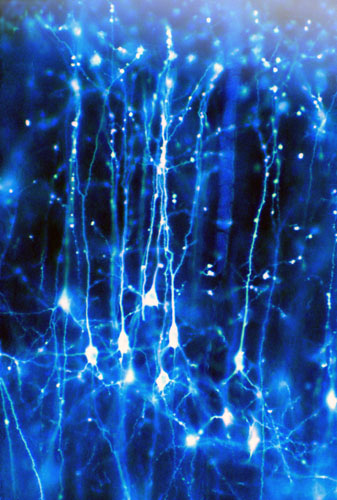
NERVOUS
SYSTEM: (Marieb et.al.)
The
Nervous System has three overlapping functions:
 Sensory receptors monitor changes inside and outside the
body
Sensory receptors monitor changes inside and outside the
body§ Gathered information – sensory input
 CNS Processes and interprets sensory input
CNS Processes and interprets sensory input§ Makes decisions – integration
 Dictates a response by activating effector organs
Dictates a response by activating effector organs§ Response – motor output
 Cells are densely packed and intertwined and has two main cell types
Cells are densely packed and intertwined and has two main cell types§ Neurons – transmit electrical signals
§ Support cells (neuroglial cells) – non-excitable, surround & wrap neurons
Neuron:
Ø conduct electrical impulses along the plasma membrane – graded and action potential.
Ø can live and function for a lifetime
Ø does not divide – fetal neurons lose their ability to
undergo mitosis; neural stem cells are an exception
Ø high metabolic rate – require abundant oxygen and glucose
Axons (nerve fibers)
• Neuron has only one axon, but it can branch
• Impulse generator and conductor
• Transmits action potentials away from the cell body
• Chromatophilic bodies absent
• No protein synthesis in axon
Neurofilaments, actin microfilaments, and microtubules
• Provide strength along length of axon
• Aid in the transport of substances to and from the cell body
• Axonal transport
Dendrites
• Extensively branching from the cell body
• Transmit electrical signals (graded potentials) toward the cell body
• Chromatophilic bodies – only extend into the basal part of dendrites
Function as receptive sites
Axons (nerve fibers)
• Neuron has only one axon, but it can branch
• Impulse generator and conductor
• Transmits action potentials away from the cell body
• Chromatophilic bodies absent
• No protein synthesis in axon
Neurofilaments, actin microfilaments, and microtubules
• Provide strength along length of axon
• Aid in the transport of substances to and from the cell body
• Axonal transport
Dendrites
• Extensively branching from the cell body
• Transmit electrical signals (graded potentials) toward the cell body
• Chromatophilic bodies – only extend into the basal part of dendrites
Function as receptive sites
